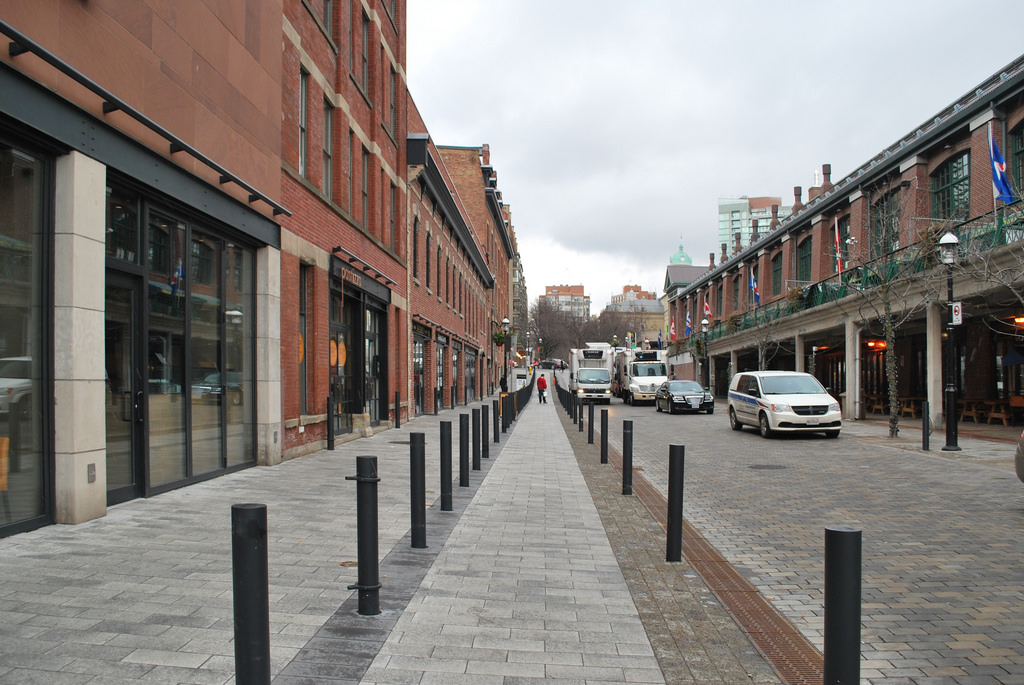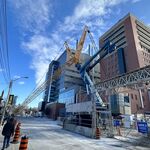Heritage Toronto, a City of Toronto arms-length agency tasked with promoting our architectural, cultural, natural and archaeological heritage, released its 'State of Heritage Report' today. The report evaluates the current state of heritage in Toronto and includes recommendations to continue strengthening historical preservation.
The timing of the report is particularly crucial. It comes following a change in leadership at City Hall as new Mayor John Tory takes the top job amid a recent Budget Committee decision eliminating four planned heritage positions; staff which would be assigned to study and manage Heritage Conservation Districts. With each report now scheduled following a municipal election, the 2015 report comes after a fairly tumultuous few years for heritage advocates who lament the demolition of several historic structures including the Empress Hotel at Yonge and Gould and 81 Wellesley Street East.
City Councillors who were in attendance at the City Hall briefing included Councillors Matlow, Doucette, Layton, Cressy, Nunziata, Mihevc, Wong-Tam, Fragedakis and Burnside.
 Few Councillors were in attendance, image by Marcus Mitanis
Few Councillors were in attendance, image by Marcus Mitanis
For the first time, the report grades action on recommendations from the previous report of four years ago in order to determine how the heritage environment has changed. The report concludes that while heritage is becoming more entrenched in city planning—which has been reflected through Official Plan policies—legislation needs to be amended to allow for stronger protection and greater review timelines.
Many of the grades are related to governance, legislation and resource management. Aiming to take a proactive rather than a reactive approach to heritage designation, a summary of the grades related to select recommendations is included below:
- Allocate more staff and resources to enforce existing laws and heritage policies: B-
- Revise the Official Plan to offer well-defined policy on heritage resources: A
- Enact stronger legislation and longer timelines for demolition applications to receive a proper review from Heritage Preservation Services (HPS): D
- Work towards a more holistic approach to heritage conservation by including cultural landscapes and natural heritage features in listings on the Inventory of Heritage Properties: B
- Reposition heritage as a progressive aspect of better city planning, and an explicit move towards a ‘greener’ city, to be woven into development decisions: A-
- Update and consolidate the Inventory of Heritage Properties into a single, easily-accessible source: B+
- Revitalize and reinitiate Heritage property owner financial incentive programs such as the Heritage Property Tax Relief and the Heritage Grants program in order to promote protection of heritage sites and buildings among private property owners: B-
The report also found that educational programming and displays around heritage have been lacking, with grades ranging from C- to B-.
 The Maclean House was saved from demolition and converted into multiple residences, image by Marcus Mitanis
The Maclean House was saved from demolition and converted into multiple residences, image by Marcus Mitanis
Stakeholders participating in the 2010/2011 report expressed that there was a lack of vision and leadership at the political and bureaucratic levels, also noting that volunteers have often felt disenfranchised by the complex process surrounding heritage designation. The 2015 report explains that these beliefs are still very widespread today. Despite significant changes to the Ontario Heritage Act in 2005 which gave municipal councils the authority to deny a demolition permit, participants felt that developers and the City often reached compromises that sacrificed the integrity of heritage properties. Façadism, the process of retaining only the façade of a structure, continues more or less unabated today. Stakeholders also criticized the lack of heritage representation at the Ontario Municipal Board.
There is good news however. Though currently under appeal, the report acknowledged the improvements to the City's Official Plan in 2012, which more than tripled the number of heritage policies from 14 to 48. There is also a growing emphasis on natural heritage policies as the Official Plan will now include an additional 68 Environmentally Significant Areas compared to the current 14. The report commended the City for studying five new Heritage Conservation Districts, including Historic Yonge. A recent bylaw was passed for the Historic Yonge district allowing the City to place interim controls on buildings within its boundaries. The bylaw, in force for one year, gives the City the opportunity to complete the Heritage Conservation District Study while protecting the buildings from demolition and alterations.
 The restored Market Street now fitted with restaurants and shops, image by Marcus Mitanis
The restored Market Street now fitted with restaurants and shops, image by Marcus Mitanis
The report outlines goals for the next four years, including final approval of the proposed Official Plan heritage policies, a proactive survey of potential heritage properties, the creation of a new Heritage Management Plan and finally taking action on a City of Toronto museum. The full report and its recommendations can be viewed at the Heritage Toronto website.
What steps do you think the City of Toronto can take to preserve our heritage assets? As always, if you want to get involved in the discussion, leave a comment in the field provided below.

 1.2K
1.2K 








































